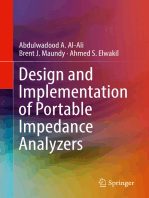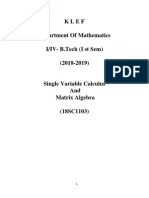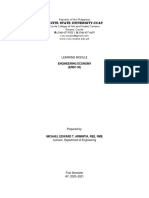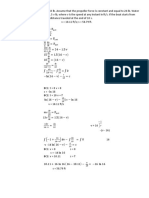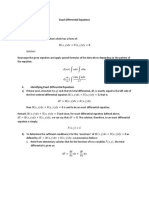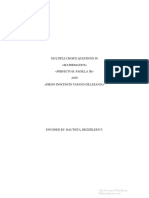Professional Documents
Culture Documents
Reliability Evaluation of Fire Extinguisher - An Innovative Safety Approach
0 ratings0% found this document useful (0 votes)
161 views4 pagesReliability evaluation of an engineering system
or component or element is very important in order to
predict its availability or unavailability and other
important indices related to the component or system as a
whole
Original Title
Reliability Evaluation of Fire Extinguisher – an Innovative Safety Approach
Copyright
© © All Rights Reserved
Available Formats
PDF, TXT or read online from Scribd
Share this document
Did you find this document useful?
Is this content inappropriate?
Report this DocumentReliability evaluation of an engineering system
or component or element is very important in order to
predict its availability or unavailability and other
important indices related to the component or system as a
whole
Copyright:
© All Rights Reserved
Available Formats
Download as PDF, TXT or read online from Scribd
0 ratings0% found this document useful (0 votes)
161 views4 pagesReliability Evaluation of Fire Extinguisher - An Innovative Safety Approach
Reliability evaluation of an engineering system
or component or element is very important in order to
predict its availability or unavailability and other
important indices related to the component or system as a
whole
Copyright:
© All Rights Reserved
Available Formats
Download as PDF, TXT or read online from Scribd
You are on page 1of 4
Volume 6, Issue 5, May – 2021 International Journal of Innovative Science and Research Technology
ISSN No:-2456-2165
Reliability Evaluation of Fire Extinguisher –
An Innovative Safety Approach
Aditya Tiwary Rohit Patel
Associate Professor, Dept. of Fire Technology & Safety UG Final year students, Dept. of Fire Technology & Safety
Engineering, IPS Academy, Institute of Engineering and Engineering, IPS Academy, Institute of Engineering and
science, Indore (M.P), India science, Indore (M.P), India
Saiyam Jain Shreyansh Jain
UG Final year students, Dept. of Fire Technology & Safety UG Final year students, Dept. of Fire Technology & Safety
Engineering, IPS Academy, Institute of Engineering and Engineering, IPS Academy, Institute of Engineering and
science, Indore (M.P), India science, Indore (M.P), India
Shivam Rathore Sagar Soni
UG Final year students, Dept. of Fire Technology & Safety UG Final year students, Dept. of Fire Technology & Safety
Engineering, IPS Academy, Institute of Engineering and Engineering, IPS Academy, Institute of Engineering and
science, Indore (M.P), India science, Indore (M.P), India
Seejan Khan Sami Shaikh
UG Final year students, Dept. of Fire Technology & Safety UG Final year students, Dept. of Fire Technology & Safety
Engineering, IPS Academy, Institute of Engineering and Engineering, IPS Academy, Institute of Engineering and
science, Indore (M.P), India science, Indore (M.P), India
Abstract:- Reliability evaluation of an engineering system
or component or element is very important in order to Fire Extinguisher is very important in order to control
predict its availability or unavailability and other fire at a particular place. In order to minimize the effect of
important indices related to the component or system as a fire at any location proper utilization along with the reliability
whole. Reliability is the variable which tells about the of the equipment is very important aspect to look after.
availability or unavailability of the component under Therefore there is need for evaluation of the reliability. In this
proper working conditions for a given period of time. In paper reliability evaluation of Fire Extinguishers installed for
this paper a study based on reliability analysis of fire safety is done and different reliability parameters are
extinguishers installed for safety purpose is evaluated and obtained.
different variable are obtained. A Fire Extinguisher is
very important to control in case of fire for safety
purpose.
Keywords:- Reliability, Availability, Fire Extinguisher, Fire
Fighting, Safety.
I. INTRODUCTION
A Markov cut-set composite approach was proposed by
Singh et al. [1]. The reliability indices have been determined
at any point of composite system by conditional probability Fig. 1(i) Fire Extinguisher
approach by Billinton et al. [2]. Wojczynski et al. [3]
discussed DS simulation studies. New indices based on
probabilistic models and fuzzy concepts were presented by
Verma et al. [4]. Various reliability indices studies were
presented [5-9]. Different methods for reliability of
distribution system were discussed [10-15]. Studies based on
fault tree, safety, DS reliability are presented [16-24]. Tiwary
et al. [25] has discussed a methodology for evaluation of
customer orientated indices and reliability of a meshed power
distribution system. Reliability evaluation of engineering
system is discussed [26]. Battu et al. [27] discussed a method
using MCS. Various reliability assessment has been presented Fig. 1(ii) Fire Extinguisher
[28-31].
IJISRT21MAY290 www.ijisrt.com 244
Volume 6, Issue 5, May – 2021 International Journal of Innovative Science and Research Technology
ISSN No:-2456-2165
II. RELIABILITY EVALUATION OF
COMPONENTS AND ITS IMPLEMENTATION
The reliability of the system having constant failure rate
is evaluated by using the following relation.
R(t)=e^(-λt) (1)
Where R(t) represents the reliability of each component.
λ represents the failure rate per year and t represents time
period which is taken as one year.
The mean time to failure (MTTF) can be obtained as
follows:
MTTF=1/λ (2)
Fig. 3 Description of different types of Fire Extinguisher
III. RESULTS AND DISCUSSION
Table 1 shows the initial data for the fire extinguishers.
Total number of seven fire extinguishers was taken for the
study purpose. Table 2 provides the evaluated reliability for
each and every fire extinguishers. For fire extinguishers 1 to 7
evaluated reliability value are 0.991536, 0.992528, 0.992032,
0.998002, 0.996606, 0.994615 and 0.995212 respectively.
Table 3 gives up the value of MTTF of each and every fire
extinguishers taken for the study. Fig. 1 provides the
magnitude of reliability of each and every fire extinguisher
from 1 to 7. Fig. 2 gives magnitude of MTTF.
Fig. 2 Component description of Fire Extinguisher
Table 1: Initial data for different fire extinguishers.
fire extinguisher 1 2 3 4 5 6 7
Failure rate(*10-4) 85 75 80 20 34 54 48
Table 2: Evaluated reliability for different fire extinguishers.
fire extinguisher 1 2 3 4 5 6 7
Evaluated Reliability 0.991536 0.992528 0.992032 0.998002 0.996606 0.994615 0.995212
Table 3: Evaluated MTTF for different fire extinguishers.
fire extinguisher 1 2 3 4 5 6 7
Evaluated MTTF 117.64 113.33 125.00 500.00 294.11 185.18 208.33
IJISRT21MAY290 www.ijisrt.com 245
Volume 6, Issue 5, May – 2021 International Journal of Innovative Science and Research Technology
ISSN No:-2456-2165
Components and Systems, Vol.30, No. 7, 2002, pp. 679-
691.
[5]. Z. Zheng, L. Cui, Alan G. Hawkes, “A study on a
single-unit Markov repairable system with repair time
omission”, IEEE Trans. on Reliability, Vol. 55, No.2,
2006, pp. 182-188.
[6]. P. Jirutitijaroen, C. singh, “Comparison of simulation
methods for power system reliability indexes and their
distributions”, IEEE Trans. on Power Systems, Vol.23,
No.2, 2008, pp. 486-493.
[7]. O. Dzobe, C. T. Gaunt, R. Herman, “Investigating the
use of probability distribution functions in reliability-
worth analysis of electric power systems”, Int. J. of
Figure 1: Magnitude of Evaluated reliability for different fire Electrical Power and Energy Systems, Vol. 37, 2012,
extinguishers. pp. 110-116.
[8]. I. S. Bae, J. O. Kim, “Reliability evaluation of
customers in a microgrid”, IEEE Trans. on Power
Systems, Vol. 23, No. 3, 2008, pp. 1416-1422.
[9]. R. Billinton, P. Wang, “Reliability-network-equivalent
approach to distribution-system-reliability evaluation”,
IEE Proc. generation, transmission and distribution,
Vol. 145, No. 2, 1998, pp. 149-153.
[10]. Aditya Tiwary, “Customer and energy based indices
consideration for reliability enhancement of distribution
system using Improved Teaching Learning based
optimization”, International Journal of Latest Trends in
Engineering and Technology, Vol. 9, No. 1, Sept. 2017,
pp. 254-258.
[11]. Aditya Tiwary, “An Innovative Self-Adaptive Multi-
Figure 2: Magnitude of Evaluated MTTF for different fire Population Jaya Algorithm based Technique for
extinguishers. Evaluation and Improvement of Reliability Indices of
Electrical Power Distribution System”, International
IV. CONCLUSION Journal on Future Revolution in Computer Science &
Communication Engineering, Vol. 4, No. 2, Feb. 2018,
Reliability evaluation of an engineering system or pp. 299-302.
component or element is very important in order to predict its [12]. Jirutitijaroen P, singh C. “Comparison of simulation
availability or unavailability and other important indices. In methods for power system reliability indexes and their
this paper reliability evaluation of fire extinguishers is done distribution”, IEEE Trans Power Syst, 23(2), 2008, pp.
and different reliability parameters are obtained. The 486-92.
reliability is evaluated based on the failure rate provided. [13]. Aditya Tiwary, R. Arya, S. C. Choube and L. D. Arya,“
Mean time to failure (MTTF) an important indices is also Determination of reliability indices for distribution
obtained for the each and every fire extinguisher. system using a state transition sampling technique
accounting random down time omission”, Journal of
REFERENCES The Institution of Engineers (India): series B (Springer),
Vol. 94, No. 1 , 2013, pp. 71-83.
[1]. C. Singh, “Markov cut-set approach for the reliability [14]. Aditya Tiwary, “Inspection-Repair-Based Availability
evaluation of transmission and distribution systems”, Optimization of Distribution System Using Bare Bones
IEEE Trans. on Power Apparatus and Systems, Vol. Particle Swarm Optimization”, Chapter in Book Series
PAS-100, No. 6, 1981, pp. 2719-2725. Computational Intelligence: Theories, Applications and
[2]. R. Billinton, “Composite system reliability evaluation”, Future Directions – Volume II, Advances in Intelligent
IEEE Trans. on Power Apparatus and Systems, Vol. Systems and computing 799, Springer, 2019.
PAS-88, No. 4, 1969, pp. 276-281. [15]. Aditya Tiwary, R. Arya, L. D. Arya and S. C. Choube,
[3]. E. Wojczynski, R. Billinton, “Effects of distribution “Bootstrapping based technique for evaluating
system reliability index distributions upon interruption reliability indices of RBTS distribution system
cost/reliability worth estimates”, IEEE Trans. on Power neglecting random down time”, The IUP Journal of
Apparatus and Systems, PAS-104, Vol. 11, 1985, pp. Electrical and Electronics Engineering, Vol. X, No. 2,
3229-3235. April 2017, pp. 48-57.
[4]. A. K. Verma, A. Srividya, H. M. R. Kumar, “A [16]. Volkanavski, Cepin M, Mavko B. “Application of fault
framework using uncertainties in the composite power tree analysis for assessment of the power system
system reliability evaluation”, Electric Power reliability”, Reliab Eng Syst Safety, 94(6), 2009, pp.
1116-27.
IJISRT21MAY290 www.ijisrt.com 246
Volume 6, Issue 5, May – 2021 International Journal of Innovative Science and Research Technology
ISSN No:-2456-2165
[17]. Li BM, Su CT, Shen CL. “The impact of covered [29]. Aditya Tiwary and Swati Tiwary, “Evaluation of
overhead conductors on distribution reliability and Customer Orientated Indices and Reliability Study of
safety” Int J Electr Power Energy Syst, 32(4). 2010, pp. Electrical Feeder System”, Reliability: Theory and
281-9. Applications, Vol. 15, No. 3(58), September 2020, pp.
[18]. Aditya Tiwary, “Reliability enhancement of distribution 36-43.
system using Teaching Learning based optimization [30]. Aditya Tiwary, Ritik Yadav, Praveen R. Patel, Praveen
considering customer and energy based indices”, K. Patel, Satish Patle, Rahul Gurjar, Shivam Dabli, “An
International Journal on Future Revolution in Computer Innovative Safety Approach for Reliability Analysis of
Science & Communication Engineering, Vol. 3, No. 10, Hose Reel System”, International Journal of Innovative
Oct. 2017, pp. 58-62. Science and Research Technology, Vol. 5, No, 10, Oct.
[19]. Aditya Tiwary, “Self-Adaptive Multi-Population Jaya 2020, pp. 870-873.
Algorithm based Reactive Power Reserve Optimization [31]. AdityaTiwary, RitikYadav, Praveen R. Patel, Praveen
Considering Voltage Stability Margin Constraints”, K. Patel, SatishPatle, Rahul Gurjar, ShivamDabli,
International Journal on Future Revolution in Computer Shailendra Raghuwanshi “Reliability Assessment of
Science & Communication Engineering, Vol. 4, No. 1, Practical Hose Reel System a contemporary
Jan. 2018, pp. 341-345. Perspective”, International Journal of Innovative
[20]. R. Arya , Aditya Tiwary , S. C. Choube and L. D. Arya, Science and Research Technology, Vol. 6, No. 3, March
“A smooth bootstrapping based technique for evaluating 2021, pp. 1318-1321.
distribution system reliability indices neglecting random
interruption duration”, Int. J. of Electrical Power and
Energy System, (ELSEVIER), Vol.51 , 2013,pp. 307-
310.
[21]. A. Tiwary, “Inspection–Maintenance-Based
Availability Optimization of Feeder Section Using
Particle Swarm optimization”, Soft Computing for
Problem Solving-Advances in Intelligent Systems and
Computing, 816, 2018, pp. 257-272.
[22]. M. Bin Li, C. Tzong Su, C. Lung Shen, “The impact of
covered overhead conductors on distribution reliability
and safety”, Int. J. of Electrical Power and Energy
System, (ELSEVIER), Vol. 32, 2010, pp. 281-289.
[23]. Aditya Tiwary, “Reliability evaluation of radial
distribution system – A case study”, Int. J. of
Reliability: Theory and Applications, 14, 4(55), 2019,
pp. 9-13.
[24]. I. Sarantakos, D. M. Greenwood, J. Yi, S. R. Blake, P.
C. Taylor, “A method to include component condition
and substation reliability into distribution system
reconfiguration”, Int. J. of Electrical Power and Energy
System, (ELSEVIER), Vol. 109, 2019, pp. 122-138.
[25]. Aditya Tiwary, “Customer orientated indices and
reliability evaluation of meshed power distribution
system”, Int. J. of Reliability: Theory and Applications,
15, 1(56), 2020, pp. 10-19.
[26]. Aditya Tiwary and Praveen Patel, “Reliability
Evaluation of Hose Reel System - A Practical
Approach”, Journal of Industrial Safety Engineering,
Vol. 7, No. 2, September 2020, pp. 30-34.
[27]. N. R. Battu, A. R. Abhyankar, N. Senroy, “Reliability
Compliant Distribution System Planning Using Monte
Carlo Simulation”, Electric power components and
systems, Vol. 47, 2019, pp. 985-997.
[28]. Aditya Tiwary, “Application of Non-Parametric
Bootstrap Technique for evaluating MTTF and
Reliability of a Complex Network with Non-Identical
Component Failure Laws”, Reliability: Theory and
Applications, Vol. 15, No. 3(58), September 2020, pp.
62-69.
IJISRT21MAY290 www.ijisrt.com 247
You might also like
- Design and Implementation of Portable Impedance AnalyzersFrom EverandDesign and Implementation of Portable Impedance AnalyzersNo ratings yet
- Determination of Setting Time of Hydraulic Cement: Standard Test MethodsDocument4 pagesDetermination of Setting Time of Hydraulic Cement: Standard Test MethodsJenevive TumacderNo ratings yet
- Compiled Lecture in Engineering Economy PDFDocument78 pagesCompiled Lecture in Engineering Economy PDFLJ dela PazNo ratings yet
- Chapter 2 Errors and MistakesDocument3 pagesChapter 2 Errors and MistakesApril bruce roche PrendolNo ratings yet
- 04 - Solving Cashflow ProblemsDocument12 pages04 - Solving Cashflow ProblemsZeeshan AhmadNo ratings yet
- Svcma Co1Document44 pagesSvcma Co1Sai KrishNo ratings yet
- Module 3 EvaporationDocument22 pagesModule 3 EvaporationPrince VinceNo ratings yet
- PT Mathematics 6 q4-2Document7 pagesPT Mathematics 6 q4-2Warlita g. DassunNo ratings yet
- Probability and Combinatorics Word ProblemsDocument5 pagesProbability and Combinatorics Word ProblemsGhulam FareedNo ratings yet
- Chap3 BEKG1113 PART1Document56 pagesChap3 BEKG1113 PART1am2030No ratings yet
- Specifications: Project: Proposed Two (2) Storey Residential Location: OwnerDocument4 pagesSpecifications: Project: Proposed Two (2) Storey Residential Location: OwnerJ.P.Almera ArDesignNo ratings yet
- Ce182P-2 Ce Project 1 1 QTR SY2019-2020 July 2019 Structural Engineering Cluster F.A.A.UyDocument4 pagesCe182P-2 Ce Project 1 1 QTR SY2019-2020 July 2019 Structural Engineering Cluster F.A.A.UyemmaNo ratings yet
- Trusses 72 85Document91 pagesTrusses 72 85Carlorel AnteNo ratings yet
- Specific Gravity and Absorption TestDocument6 pagesSpecific Gravity and Absorption TestJeneza Alma BalogoNo ratings yet
- Calculus concepts and formulasDocument25 pagesCalculus concepts and formulasIan Gabriel P. PaduaNo ratings yet
- Amortization Equivalent Annual Cost-UploadDocument6 pagesAmortization Equivalent Annual Cost-Uploadniaz kilamNo ratings yet
- Chapter 1 ENSC30 PDFDocument27 pagesChapter 1 ENSC30 PDFMark Lawrence BuenviajeNo ratings yet
- Module 1 - Les #2 Deterinacy and StabilityDocument4 pagesModule 1 - Les #2 Deterinacy and StabilityRafael Ilagan100% (1)
- Boat speed and distance calculationDocument5 pagesBoat speed and distance calculationAbegail GarcimoNo ratings yet
- Direction: Based On The "Tensile Strength Test" Video Provided, All Data Are Gathered andDocument7 pagesDirection: Based On The "Tensile Strength Test" Video Provided, All Data Are Gathered andErnielle Rae Dela CruzNo ratings yet
- CEng 111 Module 1Document11 pagesCEng 111 Module 1trina malanogNo ratings yet
- Bachelor of Science in Civil Engineering (Bsce)Document2 pagesBachelor of Science in Civil Engineering (Bsce)Regina Mambaje AlferezNo ratings yet
- Experiment No. 4 Initial and Final Setting Time of CementDocument5 pagesExperiment No. 4 Initial and Final Setting Time of CementJohn Paul GutierezNo ratings yet
- Data Visualization Ehron Marc M. RiveraDocument15 pagesData Visualization Ehron Marc M. RiveraEhron RiveraNo ratings yet
- Activity 3 Data SheetDocument9 pagesActivity 3 Data SheetEli GabuatNo ratings yet
- Ce134p SyllabusDocument7 pagesCe134p SyllabuskelvinNo ratings yet
- Bituminous Fiber Sewer PipeDocument5 pagesBituminous Fiber Sewer PipeAaronNo ratings yet
- Engine displacement savings calculationDocument3 pagesEngine displacement savings calculationEzlan HarithNo ratings yet
- Problem Statement 12.16 - : Normal and Tangential Components of AccelerationDocument4 pagesProblem Statement 12.16 - : Normal and Tangential Components of AccelerationErick MangalinoNo ratings yet
- Engineering Management: Engr. Edmundo A. ObinaDocument54 pagesEngineering Management: Engr. Edmundo A. ObinaWild RiftNo ratings yet
- Engenvi NotesDocument12 pagesEngenvi NotesMariaNo ratings yet
- Units of Electricity: Exercise Problems (E, I, R, P and Q)Document3 pagesUnits of Electricity: Exercise Problems (E, I, R, P and Q)Shaft SandaeNo ratings yet
- Design and Acceptability of a Universal Concrete SpacerDocument74 pagesDesign and Acceptability of a Universal Concrete SpacerJohn Aries Almelor SarzaNo ratings yet
- G 32.05 Ft/s Z: F 12000 LBF 32.05 Ft/s 32.174 LB Ft/s 1 LBFDocument1 pageG 32.05 Ft/s Z: F 12000 LBF 32.05 Ft/s 32.174 LB Ft/s 1 LBFSingle UserNo ratings yet
- RCD Final ProjDocument98 pagesRCD Final ProjMark Jendel TomoNo ratings yet
- Carolinian Academic Integrity PledgeDocument1 pageCarolinian Academic Integrity PledgeTurbonisNo ratings yet
- Distance Education Course Guide Using Obtl Design V1: Flexible Learning A.Y. 2020-2021Document6 pagesDistance Education Course Guide Using Obtl Design V1: Flexible Learning A.Y. 2020-2021Amer ArtesanoNo ratings yet
- ConductionDocument34 pagesConductionguna sekaranNo ratings yet
- Example Problems On Static EquilibriumDocument5 pagesExample Problems On Static Equilibrium-Manvendra Pratap Singh-No ratings yet
- Mathematical&Usaefuldiscrete ExamplesDocument2 pagesMathematical&Usaefuldiscrete ExamplesJenalyn QuemadaNo ratings yet
- Research Paper DoneDocument31 pagesResearch Paper DoneEd Ed100% (1)
- Fluid DynamicsDocument70 pagesFluid DynamicsH Aries OñaNo ratings yet
- Data Analysis Week 3Document18 pagesData Analysis Week 3Christian John Paul LijayanNo ratings yet
- Astm C 566-2019Document3 pagesAstm C 566-2019Mohammed AliNo ratings yet
- Measurement of PrecipitationDocument8 pagesMeasurement of PrecipitationYo Boi KatakuriNo ratings yet
- 4 One Way SlabDocument22 pages4 One Way SlabCandice Aberin Mag-alasinNo ratings yet
- Metd1 02 PDFDocument6 pagesMetd1 02 PDFBri-AnnaNo ratings yet
- GED102 Week 4 WGNDocument5 pagesGED102 Week 4 WGNjb12345No ratings yet
- Electric Circuits Practice QuestionsDocument3 pagesElectric Circuits Practice QuestionsGrace BelloNo ratings yet
- Planning, Analysis and Design of (G+5) Hospital Building Using STAAD - ProDocument8 pagesPlanning, Analysis and Design of (G+5) Hospital Building Using STAAD - ProIndhuManiyan100% (1)
- EM 7 - EDA - Problem Set 1Document2 pagesEM 7 - EDA - Problem Set 1Ron Michael Dave Cezar0% (1)
- Barney mp4Document88 pagesBarney mp4Juan PonceNo ratings yet
- COST CONCEPTS BREAKEVENDocument22 pagesCOST CONCEPTS BREAKEVENOmar AljilaniNo ratings yet
- Exact Differential Equations GuideDocument5 pagesExact Differential Equations GuideDeomasis Patria Vi NarcisoNo ratings yet
- Ejercicos DinamicaDocument3 pagesEjercicos DinamicaMargarita Balza100% (1)
- Waves Help GuideDocument50 pagesWaves Help Guidealchemist2000No ratings yet
- 3 - Multiple Choice Questions in Engineering MathematicsDocument159 pages3 - Multiple Choice Questions in Engineering MathematicsPJBautistaMaddumaNo ratings yet
- Portable Sound Wave Fire ExtinguisherDocument3 pagesPortable Sound Wave Fire ExtinguisherInternational Journal of Innovative Science and Research TechnologyNo ratings yet
- Selection of Optimum Assembly Gap Tolerance For Motor AssemblyDocument8 pagesSelection of Optimum Assembly Gap Tolerance For Motor AssemblyIJRASETPublicationsNo ratings yet
- An Innovative Safety Approach For Reliability Analysis of Hose Reel SystemDocument4 pagesAn Innovative Safety Approach For Reliability Analysis of Hose Reel SystemInternational Journal of Innovative Science and Research TechnologyNo ratings yet
- Comparatively Design and Analyze Elevated Rectangular Water Reservoir with and without Bracing for Different Stagging HeightDocument4 pagesComparatively Design and Analyze Elevated Rectangular Water Reservoir with and without Bracing for Different Stagging HeightInternational Journal of Innovative Science and Research TechnologyNo ratings yet
- Diabetic Retinopathy Stage Detection Using CNN and Inception V3Document9 pagesDiabetic Retinopathy Stage Detection Using CNN and Inception V3International Journal of Innovative Science and Research TechnologyNo ratings yet
- The Utilization of Date Palm (Phoenix dactylifera) Leaf Fiber as a Main Component in Making an Improvised Water FilterDocument11 pagesThe Utilization of Date Palm (Phoenix dactylifera) Leaf Fiber as a Main Component in Making an Improvised Water FilterInternational Journal of Innovative Science and Research TechnologyNo ratings yet
- Advancing Healthcare Predictions: Harnessing Machine Learning for Accurate Health Index PrognosisDocument8 pagesAdvancing Healthcare Predictions: Harnessing Machine Learning for Accurate Health Index PrognosisInternational Journal of Innovative Science and Research TechnologyNo ratings yet
- Dense Wavelength Division Multiplexing (DWDM) in IT Networks: A Leap Beyond Synchronous Digital Hierarchy (SDH)Document2 pagesDense Wavelength Division Multiplexing (DWDM) in IT Networks: A Leap Beyond Synchronous Digital Hierarchy (SDH)International Journal of Innovative Science and Research TechnologyNo ratings yet
- Electro-Optics Properties of Intact Cocoa Beans based on Near Infrared TechnologyDocument7 pagesElectro-Optics Properties of Intact Cocoa Beans based on Near Infrared TechnologyInternational Journal of Innovative Science and Research TechnologyNo ratings yet
- Formulation and Evaluation of Poly Herbal Body ScrubDocument6 pagesFormulation and Evaluation of Poly Herbal Body ScrubInternational Journal of Innovative Science and Research TechnologyNo ratings yet
- Terracing as an Old-Style Scheme of Soil Water Preservation in Djingliya-Mandara Mountains- CameroonDocument14 pagesTerracing as an Old-Style Scheme of Soil Water Preservation in Djingliya-Mandara Mountains- CameroonInternational Journal of Innovative Science and Research TechnologyNo ratings yet
- The Impact of Digital Marketing Dimensions on Customer SatisfactionDocument6 pagesThe Impact of Digital Marketing Dimensions on Customer SatisfactionInternational Journal of Innovative Science and Research TechnologyNo ratings yet
- A Review: Pink Eye Outbreak in IndiaDocument3 pagesA Review: Pink Eye Outbreak in IndiaInternational Journal of Innovative Science and Research TechnologyNo ratings yet
- Auto Encoder Driven Hybrid Pipelines for Image Deblurring using NAFNETDocument6 pagesAuto Encoder Driven Hybrid Pipelines for Image Deblurring using NAFNETInternational Journal of Innovative Science and Research TechnologyNo ratings yet
- Design, Development and Evaluation of Methi-Shikakai Herbal ShampooDocument8 pagesDesign, Development and Evaluation of Methi-Shikakai Herbal ShampooInternational Journal of Innovative Science and Research Technology100% (3)
- A Survey of the Plastic Waste used in Paving BlocksDocument4 pagesA Survey of the Plastic Waste used in Paving BlocksInternational Journal of Innovative Science and Research TechnologyNo ratings yet
- Cyberbullying: Legal and Ethical Implications, Challenges and Opportunities for Policy DevelopmentDocument7 pagesCyberbullying: Legal and Ethical Implications, Challenges and Opportunities for Policy DevelopmentInternational Journal of Innovative Science and Research TechnologyNo ratings yet
- Hepatic Portovenous Gas in a Young MaleDocument2 pagesHepatic Portovenous Gas in a Young MaleInternational Journal of Innovative Science and Research TechnologyNo ratings yet
- Explorning the Role of Machine Learning in Enhancing Cloud SecurityDocument5 pagesExplorning the Role of Machine Learning in Enhancing Cloud SecurityInternational Journal of Innovative Science and Research TechnologyNo ratings yet
- Navigating Digitalization: AHP Insights for SMEs' Strategic TransformationDocument11 pagesNavigating Digitalization: AHP Insights for SMEs' Strategic TransformationInternational Journal of Innovative Science and Research TechnologyNo ratings yet
- Perceived Impact of Active Pedagogy in Medical Students' Learning at the Faculty of Medicine and Pharmacy of CasablancaDocument5 pagesPerceived Impact of Active Pedagogy in Medical Students' Learning at the Faculty of Medicine and Pharmacy of CasablancaInternational Journal of Innovative Science and Research TechnologyNo ratings yet
- Automatic Power Factor ControllerDocument4 pagesAutomatic Power Factor ControllerInternational Journal of Innovative Science and Research TechnologyNo ratings yet
- Mobile Distractions among Adolescents: Impact on Learning in the Aftermath of COVID-19 in IndiaDocument2 pagesMobile Distractions among Adolescents: Impact on Learning in the Aftermath of COVID-19 in IndiaInternational Journal of Innovative Science and Research TechnologyNo ratings yet
- Review of Biomechanics in Footwear Design and Development: An Exploration of Key Concepts and InnovationsDocument5 pagesReview of Biomechanics in Footwear Design and Development: An Exploration of Key Concepts and InnovationsInternational Journal of Innovative Science and Research TechnologyNo ratings yet
- Studying the Situation and Proposing Some Basic Solutions to Improve Psychological Harmony Between Managerial Staff and Students of Medical Universities in Hanoi AreaDocument5 pagesStudying the Situation and Proposing Some Basic Solutions to Improve Psychological Harmony Between Managerial Staff and Students of Medical Universities in Hanoi AreaInternational Journal of Innovative Science and Research TechnologyNo ratings yet
- The Effect of Time Variables as Predictors of Senior Secondary School Students' Mathematical Performance Department of Mathematics Education Freetown PolytechnicDocument7 pagesThe Effect of Time Variables as Predictors of Senior Secondary School Students' Mathematical Performance Department of Mathematics Education Freetown PolytechnicInternational Journal of Innovative Science and Research TechnologyNo ratings yet
- Drug Dosage Control System Using Reinforcement LearningDocument8 pagesDrug Dosage Control System Using Reinforcement LearningInternational Journal of Innovative Science and Research TechnologyNo ratings yet
- Securing Document Exchange with Blockchain Technology: A New Paradigm for Information SharingDocument4 pagesSecuring Document Exchange with Blockchain Technology: A New Paradigm for Information SharingInternational Journal of Innovative Science and Research TechnologyNo ratings yet
- Enhancing the Strength of Concrete by Using Human Hairs as a FiberDocument3 pagesEnhancing the Strength of Concrete by Using Human Hairs as a FiberInternational Journal of Innovative Science and Research TechnologyNo ratings yet
- Formation of New Technology in Automated Highway System in Peripheral HighwayDocument6 pagesFormation of New Technology in Automated Highway System in Peripheral HighwayInternational Journal of Innovative Science and Research TechnologyNo ratings yet
- Supply Chain 5.0: A Comprehensive Literature Review on Implications, Applications and ChallengesDocument11 pagesSupply Chain 5.0: A Comprehensive Literature Review on Implications, Applications and ChallengesInternational Journal of Innovative Science and Research TechnologyNo ratings yet
- Intelligent Engines: Revolutionizing Manufacturing and Supply Chains with AIDocument14 pagesIntelligent Engines: Revolutionizing Manufacturing and Supply Chains with AIInternational Journal of Innovative Science and Research TechnologyNo ratings yet
- The Making of Self-Disposing Contactless Motion-Activated Trash Bin Using Ultrasonic SensorsDocument7 pagesThe Making of Self-Disposing Contactless Motion-Activated Trash Bin Using Ultrasonic SensorsInternational Journal of Innovative Science and Research TechnologyNo ratings yet
- Critical P&ID ReviewDocument16 pagesCritical P&ID ReviewkhanasifalamNo ratings yet
- Benefit of Early Class II Treatment: Progress Report of A Two-Phase Randomized Clinical TrialDocument11 pagesBenefit of Early Class II Treatment: Progress Report of A Two-Phase Randomized Clinical TrialJoshua StalinNo ratings yet
- Assessment Task 2 - BSBRSK501Document36 pagesAssessment Task 2 - BSBRSK501jeanilyn tanNo ratings yet
- ENG-701 Research Methodology: School of Arts and Social SciencesDocument4 pagesENG-701 Research Methodology: School of Arts and Social SciencesFaisal JahangeerNo ratings yet
- IELTS LISTENING PREP: EDUCATION TOPICSDocument3 pagesIELTS LISTENING PREP: EDUCATION TOPICSDucNo ratings yet
- Piata de Legume-Fructe 2015-2022 - Prezentare RezumativaDocument5 pagesPiata de Legume-Fructe 2015-2022 - Prezentare RezumativamanageranticrizaNo ratings yet
- Dett 621 9040 SyllabusDocument30 pagesDett 621 9040 Syllabusapi-241955651No ratings yet
- Stem CellsDocument7 pagesStem CellsPrasant NatarajanNo ratings yet
- Template FMEA5Document5 pagesTemplate FMEA5Puneet SharmaNo ratings yet
- Management and Behavioural Training E-BrochureDocument7 pagesManagement and Behavioural Training E-BrochuresunilkumarchaudharyNo ratings yet
- DADM AssignmentDocument3 pagesDADM AssignmentSamrin KhanNo ratings yet
- Elementary EdDocument2 pagesElementary EdEmiNo ratings yet
- HR Scorecard Strategic AlignmentDocument21 pagesHR Scorecard Strategic AlignmentMayuri DasNo ratings yet
- Extent of The Relationship Between Burnout Syndrome and Resilience On Factors Implicit To The Teaching Profession. A Systematic Review 2021Document24 pagesExtent of The Relationship Between Burnout Syndrome and Resilience On Factors Implicit To The Teaching Profession. A Systematic Review 2021Eugen Neculai GazziNo ratings yet
- Director Project Management Pharmaceuticals in Strasbourg France CV Resume Pascale ClementDocument3 pagesDirector Project Management Pharmaceuticals in Strasbourg France CV Resume Pascale ClementPascaleClementNo ratings yet
- Data Analysis For Quantitative ResearchDocument26 pagesData Analysis For Quantitative ResearchOktaf Brillian KharismaNo ratings yet
- Jurnal PENGARUH KOMPRES SEREI HANGAT TERHADAP INTENSITAS NYERI ARTRITIS RHEUMATOID PADA LANJUT USIA (2020)Document8 pagesJurnal PENGARUH KOMPRES SEREI HANGAT TERHADAP INTENSITAS NYERI ARTRITIS RHEUMATOID PADA LANJUT USIA (2020)nauranazifa1No ratings yet
- Audio Tapes To Change Your Life All For 10,000. Tell A Friend To Own One Today.4 Thanks For Being KindDocument2 pagesAudio Tapes To Change Your Life All For 10,000. Tell A Friend To Own One Today.4 Thanks For Being KindVanja VujovicNo ratings yet
- Discrete vs. Continuous SolutionsDocument8 pagesDiscrete vs. Continuous Solutionsppp2010No ratings yet
- AL NOOR CAREER GUIDANCE 2022-23Document8 pagesAL NOOR CAREER GUIDANCE 2022-23Apple MayNo ratings yet
- Ford Porject CharterDocument12 pagesFord Porject Charterrishabh mehraNo ratings yet
- CreswellQI4e TB06Document6 pagesCreswellQI4e TB06Estef BrozoNo ratings yet
- Case Study of The Behavioural Intentions of Public Transportation Passengers in Kuala LumpurDocument14 pagesCase Study of The Behavioural Intentions of Public Transportation Passengers in Kuala LumpurGonuguntla BhavyaNo ratings yet
- Colwell-Chanthaphonh TEMA 2Document17 pagesColwell-Chanthaphonh TEMA 2'Lautaro Lopez GeronazzoNo ratings yet
- Tubigonwest - 302822 - Corpus - MODULE 5Document5 pagesTubigonwest - 302822 - Corpus - MODULE 5MARY JANE CORPUSNo ratings yet
- CE315-Group 8-Lab Report 4 - Gradation AnalysisDocument13 pagesCE315-Group 8-Lab Report 4 - Gradation AnalysisTomNo ratings yet
- Effect of Discipline on Grade 12 Academic PerformanceDocument27 pagesEffect of Discipline on Grade 12 Academic PerformanceRegine AdriosulaNo ratings yet
- Prodi Manajemen: e - Jurnal Riset Manajemen Fakultas Ekonomi Dan Bisnis Unisma WebsiteDocument13 pagesProdi Manajemen: e - Jurnal Riset Manajemen Fakultas Ekonomi Dan Bisnis Unisma WebsiteRifqi HanifahNo ratings yet
- Jurnal Deni (Inggris)Document9 pagesJurnal Deni (Inggris)Deni MardianaNo ratings yet
